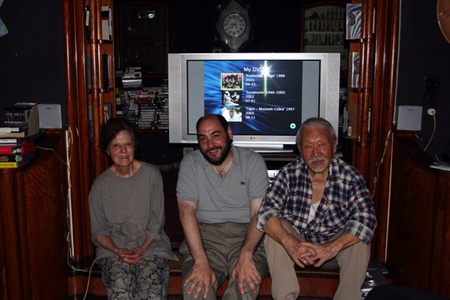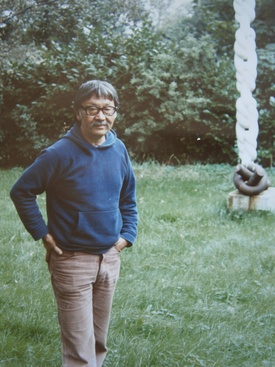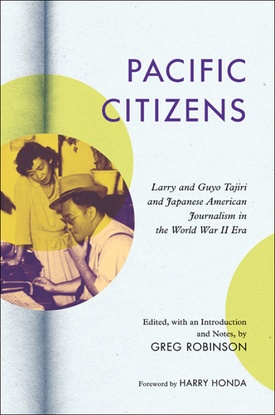Although Shinkichi Tajiri was born and spent his early years in the United States, and served in the US army during World War II as part of the renowned “Go for Broke” 442nd Regimental Combat Team, he is best known for his work as an artist in Europe. In fall 1948 Shinkichi Tajiri sailed to France. He remained in Europe in “self-imposed exile,” as he later termed it, for the rest of his life. At first, he lived in Paris. However, at the end of the 1950s, with his wife Ferdi, a Dutch woman, he moved to the Netherlands. Some years later, he bought a castle near the town of Venlo, and moved his home and studio there.
My own friendship with Shinkichi Tajiri, though fairly brief and casual, nonetheless marked me decisively. I was brought into contact with Shinkichi as a result of my interest in the work of his eldest brother Larry Tajiri, the famed journalist and wartime editor of the Pacific Citizen. In the course of my research into Larry Tajiri’s career, I had developed a friendship with Larry’s widow Guyo. She in turn introduced me to her friend Paul Okimoto. Paul, who was Shinkichi’s boyhood friend and neighbor, encouraged me to contact him. I was also encouraged to contact Shinkichi by the art historian Marian Yoshiki-Kovanick, who had collected information on Tajiri for the (now-defunct) branch of the Archives of American Art at the Huntington Library.
I first wrote to Shinkichi in April 2004, and we exchanged a few emails in the months that followed. Shinkichi sent me some research material that he had on his brother (including an unpublished essay about Larry written by their brother Vince Tajiri, a journalist and founding photo editor of Playboy magazine). I was glad to reciprocate by sending him along documents on his early artistic career that I had located in the Japanese American press. I did not feel that I had connected with Shinkichi at all on a personal level, so I was thrilled when he invited me to come stay with him at his castle in the Netherlands when I was next in Europe. I had a visit to Paris planned, and was able to schedule a side trip.
Thus it was that my partner and I came to Venlo for a long weekend’s stay in June 2006. I will never forget my first meeting with Shinkichi, when he came with his son-in-law Terry to pick us up at the train station, and take us home. Because of Shinkichi’s age—he was in his early 80s—and his formidable artistic reputation, I had been prepared to meet a venerable and perhaps austere individual. However, Shinkichi came off rather less like Picasso than like Robin Williams or Pat Morita: he spoke and moved with a briskness that belied his years, and he had an outrageous sense of humor. I noticed that he had in his car a CD of the comic Western group Kinky Friedman and the Texas Jewboys, and he laughed.

Once arrived at Shinkichi’s castle, we were installed in former servant’s quarters above the entrance archway. In the days that followed, I was privileged to be able to spend time with Shinkichi and his wife Suzanne (Suzanne, a native-born French speaker from Belgium, seemed pleased to have guests with whom she could speak French, and I amused myself teaching her a few Canadian French expressions). During the day that followed, Shinkichi spent all day at his sculpture, during which time I occupied myself, but then we met at dinnertime to converse.
Once he was free, Shinkichi took me down to his studio, showed me the sculptures he was working on, and introduced me to his assistant. I likewise was invited to visit his daughter Giotta’s studio and to see her diverse artistic creations. I was struck during my stay by Shinkichi’s keen interest in history. He showed me copies of the Tajiri family genealogical scroll and other personal artifacts, and gave me a copy of his autobiography, DVDs of his early film The Vipers (which had been one of the first prize winners at the famous Cannes Film Festival when it debuted in the postwar years) as well as other materials on his career.
He also asked me a number of questions about my ongoing researches into the wartime confinement of Japanese Americans. In fact, it was in the course of one of our talks on history that Shinkichi commissioned me to put together a collection of writings by Larry Tajiri. I have described in my book Pacific Citizens the fateful moment during a walk around the castle courtyard when Shinkichi suddenly turned to me, in apparent decision, and said, “Why don’t you do a book about Larry?” I explained that I could not possibly do a biography, as there were no surviving papers or archives about Larry Tajiri, but that I could conceivably do a selection of his writings. Shinkichi promised financial assistance, and pledged his cooperation. He telephoned his sister Yoshiko, who expressed her support for the project, and promised to intervene with Guyo Tajiri, the executor of Larry’s estate, if needed to obtain her consent to use Larry’s writings (as it turned out, when I asked Guyo myself, she immediately promised me the use of the writings). Touched by the family’s confidence in me, especially as a non-Japanese American, I agreed to take on the project.
When I left the Tajiri castle at the end of that memorable weekend, I not only had gained a writing project—I felt that I had sealed a friendship with Shinkichi. We continued to correspond in the period that followed, and at one point he told me that he had cancer. I knew that he did not have much time left. I was able to send him the proposed introduction and table of contents for Pacific Citizens, which he approved. Although he died in 2009, and did not live to see the final volume in print, it bears a dedication to him as a token of our connection.
*An alternate version of “Shinkichi Tajiri and the Paradoxes of Japanese American Identity,” was originally published in Shinkichi Tajiri’s Universal Paradoxes, Leiden, Netherlands, Leiden University Press, 2015, Helen Westgeest, ed., pp. 86-90.
© 2019 Greg Robinson







